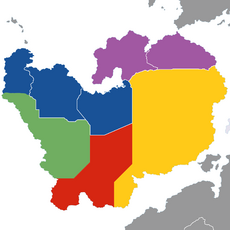Arabekh: Difference between revisions
The ©rusader (talk | contribs) |
The ©rusader (talk | contribs) (→Territories and regions: CoA size to 50) |
||
| Line 75: | Line 75: | ||
|colspan="8" style="text-align:center;"|'''[[Northwestern Arabekh]]''' | |colspan="8" style="text-align:center;"|'''[[Northwestern Arabekh]]''' | ||
|- | |- | ||
| style="text-align:center" | [[File:CoA_Haf.png| | | style="text-align:center" | [[File:CoA_Haf.png|50px]] | ||
| style="text-align:center" | {{flagicon|Hafar}} | | style="text-align:center" | {{flagicon|Hafar}} | ||
| [[Hafar]] | | [[Hafar]] | ||
| Line 84: | Line 84: | ||
|[[Al-Hamada]] | |[[Al-Hamada]] | ||
|- | |- | ||
| style="text-align:center" | [[File:Placeholder flag| | | style="text-align:center" | [[File:Placeholder flag|50px]] | ||
| style="text-align:center" | {{flagicon|Hanita}} | | style="text-align:center" | {{flagicon|Hanita}} | ||
| [[Hanita]] | | [[Hanita]] | ||
| Line 95: | Line 95: | ||
|colspan="8" style="text-align:center;"|'''[[Northeastern Arabekh]]''' | |colspan="8" style="text-align:center;"|'''[[Northeastern Arabekh]]''' | ||
|- | |- | ||
| style="text-align:center" | [[File:Placeholder flag| | | style="text-align:center" | [[File:Placeholder flag|50px]] | ||
| style="text-align:center" | {{flagicon|Aramas}} | | style="text-align:center" | {{flagicon|Aramas}} | ||
| [[Aramas]] | | [[Aramas]] | ||
| Line 104: | Line 104: | ||
|[[Sannat]] | |[[Sannat]] | ||
|- | |- | ||
| style="text-align:center" | [[File:Placeholder flag| | | style="text-align:center" | [[File:Placeholder flag|50px]] | ||
| style="text-align:center" | {{flagicon|Timarbia}} | | style="text-align:center" | {{flagicon|Timarbia}} | ||
| [[Timarbia]] | | [[Timarbia]] | ||
Revision as of 23:33, 21 April 2020
This article is incomplete because it is pending further input from participants, or it is a work-in-progress by one author. Please comment on this article's talk page to share your input, comments and questions. Note: To contribute to this article, you may need to seek help from the author(s) of this page. |
| Arabekh See list
| |
|---|---|
 Al-Buqrah sand sea in southern Hafar | |
| Area | 8,804,395 sq. km |
| Population | 68,051,936 |
| Density | TBD |
| Countries and territories | Hanita |
| Major languages | Aramasian, Midrasian language, Arabic language, Lefkosian |
| Nominal GDP | $101.250 billion |
| GDP per capita | $1487,83 |
| Time zones | UTC 0 to UTC -1 |
| Capital cities | |
Arabekh is a major continent within the northern hemisphere of Aeia. At 8.8 million square kilometers, Arabekh is the smallest of the 8 continents of Aeia. Arabekh is also the continent with the second smallest population on the planet, at 68 million people in 2015, with only Frigidarum having less inhabitants. The continent is surrounded by the Asur sea to the northeast, the Opal ocean from north, west and south, and the Arabekh channel to the east. Geographically, Arabekh also includes the Apian Isles archipelago in the Opal ocean, however, the archipelago is controlled by Mirina. Arabekh contains 4 internationally recognised states, 1 territory and X states with limited or no international recognision.
Arabekh currently ranks as the poorest continent in Aeia with an average GDP per capita of $1488. An estimated N% of the population lives below the line of poverty, with some countries reaching a level of unemployment of up to 20%. In the same time, the continent is rich on minerals and especially fossil fuels, with two of the five biggest oil exporters in Aeia being located in Northern Arabekh.
Arabekh is a home for numerous ethnicities, languages and cultures. Some of them are ranked amongst the oldest known human civilizations, dating back to the Bronze age. The continent has a rich history, with large portions of it being occupied by several Asuran, Cataian and domestic state formations throughout its ancient and medieval history. Since the 18th century, the continent has been under direct Asuran colonial rule for over 250 years, leaving a mark on its current development. Most current Arabekhi nations emerged as a result of the decoloniation processes that took place on the continent after the First Great War. Currently most of the nations on the continent suffer from serious internal instability, both in political and economical manners, and still heavily rely on their former Asuran colonizers to support their own citizens.
Etymology
History
Geology and geography
Economy
Languages
Culture
Religion
Territories and regions
| Arms | Flag | Name of region and territory |
Area (km²) |
Population | Year | GDP (Nominal) |
Capital |
|---|---|---|---|---|---|---|---|
| Northwestern Arabekh | |||||||
| Hafar | TBA | 9,872,511 | 2016 | $92,800,000,000 | Al-Hamada | ||
| File:Placeholder flag | Hanita | TBA | 14,695,345 | 2009 | $115,000,000,000 | Zaria | |
| Northeastern Arabekh | |||||||
| File:Placeholder flag | Aramas | TBA | 32,008,432 | 2015 | $156,734,000,000 | Sannat | |
| File:Placeholder flag | Timarbia | TBA | 11,475,648 | 2017 | $40,532,241,000 | Minnara | |
| Eastern Arabekh | |||||||
| Southern Arabekh | |||||||
| Western Arabekh | |||||||
| Arabekh Total | 8,804,395 | 68,051,936 | - | $101,250,000,000 | |||

